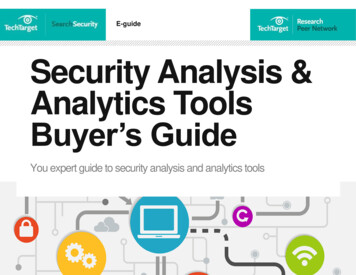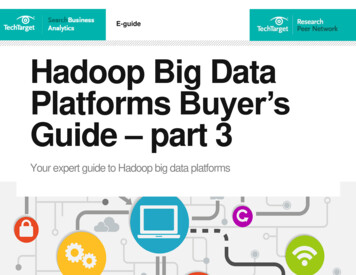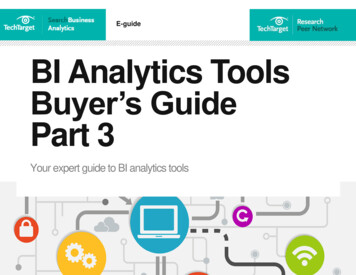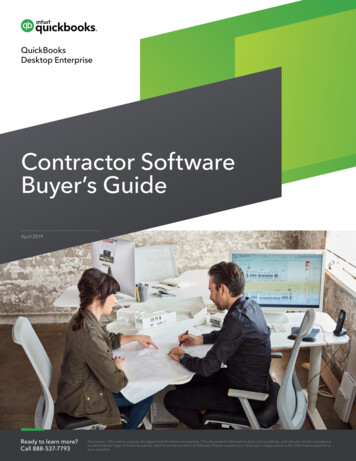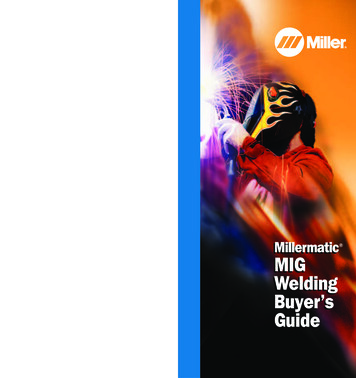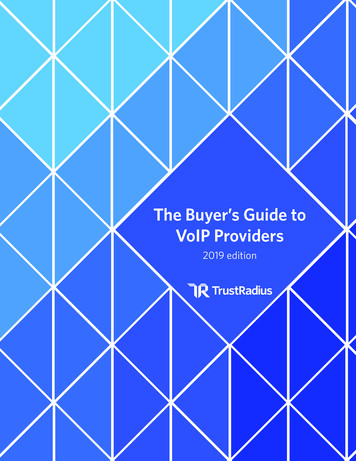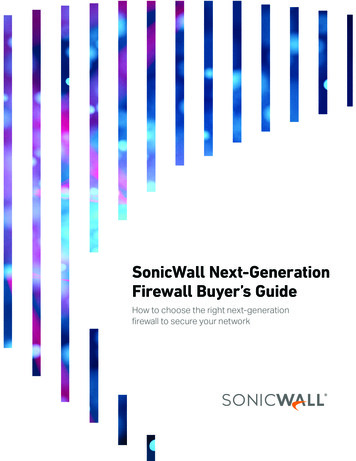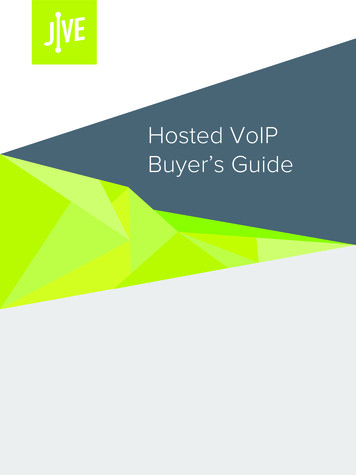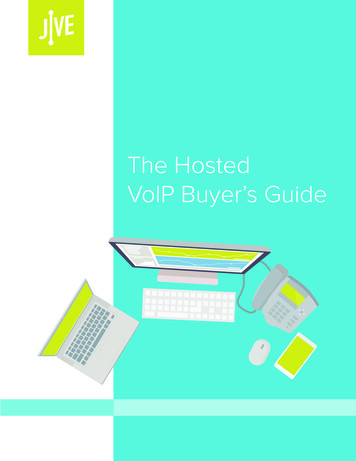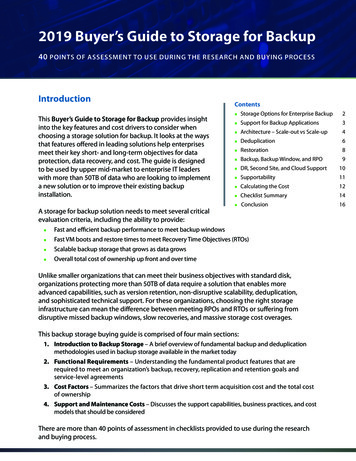
Transcription
2019 Buyer’s Guide to Storage for Backup40 POINTS OF ASSESSMENT TO USE DURING THE RESEARCH AND BUYING PROCESSIntroductionThis Buyer’s Guide to Storage for Backup provides insightinto the key features and cost drivers to consider whenchoosing a storage solution for backup. It looks at the waysthat features offered in leading solutions help enterprisesmeet their key short- and long-term objectives for dataprotection, data recovery, and cost. The guide is designedto be used by upper mid-market to enterprise IT leaderswith more than 50TB of data who are looking to implementa new solution or to improve their existing backupinstallation.A storage for backup solution needs to meet several criticalevaluation criteria, including the ability to provide:ContentsStorage Options for Enterprise Backup2Support for Backup Applications3Architecture – Scale-out vs Scale-up4Deduplication6Restoration8Backup, Backup Window, and RPO9 DR, Second Site, and Cloud Support10Supportability11Calculating the Cost12Checklist Summary14Conclusion16 Fast and efficient backup performance to meet backup windows Fast VM boots and restore times to meet Recovery Time Objectives (RTOs) Scalable backup storage that grows as data grows Overall total cost of ownership up front and over timeUnlike smaller organizations that can meet their business objectives with standard disk,organizations protecting more than 50TB of data require a solution that enables moreadvanced capabilities, such as version retention, non-disruptive scalability, deduplication,and sophisticated technical support. For these organizations, choosing the right storageinfrastructure can mean the difference between meeting RPOs and RTOs or suffering fromdisruptive missed backup windows, slow recoveries, and massive storage cost overages.This backup storage buying guide is comprised of four main sections:1. Introduction to Backup Storage – A brief overview of fundamental backup and deduplicationmethodologies used in backup storage available in the market today2. Functional Requirements – Understanding the fundamental product features that arerequired to meet an organization’s backup, recovery, replication and retention goals andservice-level agreements3. Cost Factors – Summarizes the factors that drive short term acquisition cost and the total costof ownership4. Support and Maintenance Costs – Discusses the support capabilities, business practices, and costmodels that should be consideredThere are more than 40 points of assessment in checklists provided to use during the researchand buying process.
Introduction to Storage Options for Enterprise BackupThe method used in storing backup data dramatically affects the length of time it takes toback up, retrieve, and replicate data, regardless of the backup application. Exceeding backupwindows can tax networks and slow end-user application responsiveness, forcing the ITorganization to prematurely shut off backups as the backups run into user production hours.This results in incomplete backups with no easy way to know what is and is not restorable.Several classes of backup storage solutions have emerged to improve backup including: closedend-to-end systems, backup applications with deduplication to standard disk, deduplicationstorage appliances, and intelligent hyperconverged storage for backup.Closed End-to-End SystemsClosed solutions contain backup software, storage, and compute in a single appliance, enablingorganizations to use a single vendor for their entire backup infrastructure. These systemssupport a homogeneous backup environment, restricting the ecosystem to the proprietarybackup solution. Note that enterprises with Oracle RMAN, SQL Server direct dumps, or otherbackup applications and utilities may need to look outside of the closed solutions to ensureeffective protection of their enterprise applications.Backup Applications with Deduplication to Standard DiskFor organizations requiring only a few retention versions of backups and minimal selected data,standard disk and cloud storage could meet their backup storage needs. Standard disk supportsheterogeneous environments and is a commodity solution; however, since the deduplicationis built into the backup application, only that backup application’s data can be deduplicated.If management overhead or data growth is a concern, enterprises may be better served usinghyperconverged storage solutions that reduce management overhead and cost.Deduplication Storage AppliancesTraditional deduplication storage appliances are disk-based backup storage solutions that havea front-end server controller architecture and add disk shelves as data grows. Deduplication isperformed inline on data ingestion assisted by software that runs on the backup server. Storage canbe added behind the front-end server, though performance is restricted to the primary controller.Due to the inline nature of the deduplication process and the front-end controller, deduplicationstorage appliances supply a decrease in disk consumption, with a trade-off for backup performance,scalability, and cost. A secondary concern with deduplication storage appliances is in data recovery –solutions that only store data in a deduplicated form are forced to rebuild the data prior to recoverytaking place resulting in long restore times. Deduplication appliances support heterogeneousbackup application environments as they are target-side appliances.Intelligent Hyperconverged Storage for BackupIntelligent Hyperconverged Storage for Backup solutions are disk-based backup applianceswith adaptive deduplication, purpose-built for backup. Adaptive deduplication leverages alinear scaling architecture optimized for performance, scalability and price. Backup ingestionis optimized using a landing zone disk cache, which maintains the most recent backup copyin an undeduplicated format for faster restores. Deduplication and replication is performed inparallel eliminating performance issues. Recovery is performed against full data copies that have2Page
been stored in the backup application’s native format, ensuring that RTOs are met. IntelligentHyperconverged Storage for Backup supports heterogeneous environments, and deduplicationis global.Intelligent Hyperconverged Storage for Backup is best suited to environments storing more thansix versions of backups to achieve gains in storage savings through adaptive deduplication andrequiring short RTOs where disk cache storage of full backups is a direct recovery time advantage.Storage Options Consideration Checklist Is the environment protecting more than 50TB of data? Does the environment need to store more than six versions of any backup? Are scalability and backup performance important?Support for Backup ApplicationsWhen choosing backup storage solutions, users should identify all applications being used toprotect data within the enterprise and ensure the storage solution is capable of support all ofthem. The backup storage solution should offer flexibility by supporting backup applications forboth physical and virtual servers as well as direct database dumps. While most solutions supportstandard data communication protocols and will present as a NAS device, several backupapplications have enabled optimized communication APIs and protocols. Storage solutionsshould support a variety of protocols, CIFS, NFS, Veritas OST, Oracle RMAN Channels, and theVeeam Data Mover.Specific Integration OpportunitiesWhile many backup applications are suited to using the backup storage options as NAS devicesor writing with straight CIFS, some have implemented performance optimization APIs. Someexamples include: Veritas Open Storage Technology (OST) – Veritas Open Storage is a popular feature that allows formore integrated offsite data protection, and it is an important feature if you are planning on usingNetBackup or Backup Exec. Identify solutions with integration into the Veritas OST API for fasterbackups and for unbalanced retention onsite versus offsite. Additional integration points includesupporting NetBackup Storage Lifecycle Policies and NetBackup Auto Image Replication (AIR).Veeam – If an enterprise is using Veeam, it is critical to choose a backup storage solution thatsupport Veeam’s Scale-Out Backup Repository (SOBR). Administrators can direct all jobs to a singlerepository in a scale-out system, automating job management.Solutions that are integrated with the Veeam Data Mover will increase data write performanceby using the Veeam protocol, providing up to 30% faster ingest performance than writing data viaCIFS. This improves all backup and restore processes and can create a synthetic full backup directlyon the system for increased performance.Most of Veeam’s unique features such as Sure Backup, Virtual Lab, Instant VM Recovery, Copyand Replicate require an undeduplicated backup copy on disk, which can only be provided byintelligent hyperconverged storage for backup solutions.3Page
Oracle RMAN Support of Oracle RMAN Channels – Oracle RMAN is a critically important way toeffectively protect Oracle databases. Backup storage solutions should support performance loadbalancing utilizing Oracle RMAN Channels. With Oracle RMAN Channels integration, customers getbuilt-in performance load balancing, and global deduplication across all systems. These featuresare available in intelligent hyperconverged storage for backup solutions.Backup Application Consideration Checklist Is more than one method of protecting data employed (heterogeneous vs homogeneous)? Will the environment support all backup methods simultaneously? Do you require integration with one of the vendor communication APIs, such as VeritasOST, Veeam SOBR, Veeam Data Mover, Oracle RMAN Channels? Is scale and performance a consideration?Architecture – Scale-out vs Scale-upData growth is inevitable. The typical business or organization is seeing data growth of 30% ayear, which doubles their total data every 2.5 years. This data growth presents challenges to IT toensure their backup system can scale easily to support that growth.Backup storage solutions can generally be split into two types of architectures: scale-up and scale-out.Scale-UpA scale-up architecture is a solution with a single point of entry, often referred to as a controller.The front-end controller points to disk shelves for storage. As data grows, only disk shelves areadded. At first, this is a low-cost method of protecting a larger amount of data. However, with asingle front-end controller, memory and compute resources remain fixed even as throughputrequirements increase. Backups take longer and longer to complete. When they exceed theacceptable backup window, a forklift upgrade is needed to replace the front-end controller witha bigger, faster, and more expensive one.All backup applications and large-brand deduplication appliances use the scale-up approachwhether in software or in a hardware appliance. With all of these solutions, as data grows, thebackup window does as well. (See the “Deduplication” section for additional considerations onscale-up resource consumption.)Scale-OutScale-out architectures are full appliances (processor, memory, bandwidth, and disk) in a singlesystem that can be appended to a system in a network of backup storage. As data grows, allresources are added including additional primary storage, bandwidth, processor, and memoryas well as disk capacity. This keeps the backup window fixed in length regardless of data growth,which eliminates expensive forklift upgrades.4Page
Scale-Up ArchitectureSingle Front-End ControllerExaGrid Scale-Out ArchitectureFull Servers in a Single SystemBackup Window4X TB/hrX TB/hrDISK504TB8X TB/hrX TB/hrDISK630TB10X TB/hrX TB/hrDISK756TBX TB/hrDISK1PBDISKDISK252TBGigE2X TB/hrMEM126TBCPUDISKGigEX TB/hrMEM63TBCPUBackup WindowDeduplication EngineDISKDeduplication Engine63TBDISKGigEMEMCPUDeduplication EngineX TB/hr126TBDISKGigEMEMCPUDeduplication EngineX TB/hr252TBDISKGigEMEMCPUDeduplication Engine504TBDISKGigEMEMCPUDeduplication n Engine16X TB/hrCPUIngest12X TB/hrCPUDeduplication EngineIngest1PBOut of storage and ingest - forklift upgradeDISKGigEMEMIngest not keeping up with storageCPUDeduplication Engine32X TB/hr2PBUnlike the scale-up approach where you need to guess which sized front-end controller isrequired, the scale-out approach allows you to simply add the appropriate sized appliances asyour data grows. When choosing a scale-out system, verify that any size or age appliance canbe mixed in a single system, which allows IT departments to buy compute and capacity as theyneed it. This evergreen approach also eliminates product obsolescence and forklift upgrades.Scale Considerations Checklist Understand the data growth rate in the protected environment. Look for solutions with seamless scalability that eliminate the need for forklift upgrades. Ensure the architecture will outlast the amortization term of the hardware purchase. Consider a scale-out implementation for low up-front cost and better performance over time. Ensure the environment meets the throughput requirements. Choose a solution that does not make previous model systems obsolete – Can theenvironment support different ages and models of the appliances or storage to enablescale-out over time without worrying about unsupported hardware?5Page
Deduplication: Reducing the Total Disk ConsumedWhen choosing a backup technology, consider the way the technology uses data deduplication.All vendors need to offer data deduplication to make the cost of disk storage comparable totape. Deduplication is not compression. Compression stores data at a reduced footprint byeliminating or reducing the white space not required to hold data. Deduplication is a methodof identifying existing data and ensuring that the information is only stored once. Essentially, alldeduplication technologies work by looking at data and then
by using the Veeam protocol, providing up to 30% faster ingest performance than writing data via CIFS. This improves all backup and restore processes and can create a synthetic full backup directly on the system for increased performance. Most of Veeam’s unique features such as Sure Backup, Virtual Lab, Instant VM Recovery, Copy
